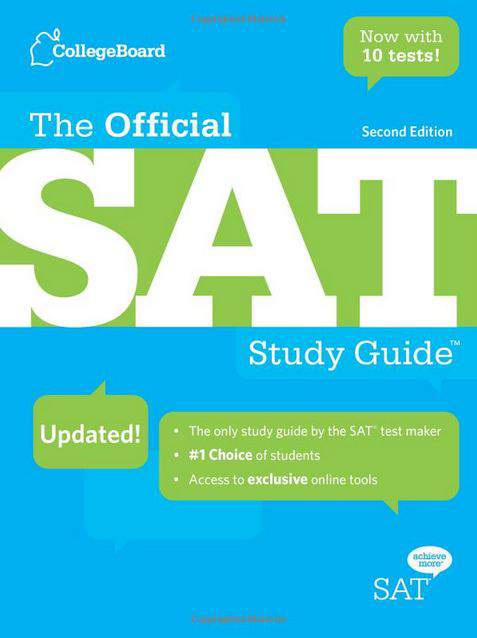

Rebekah Hendershot
Answer Guide: Section 1 (Essay)
Slide Duration:Table of Contents
Section 1: The Essay
Essay Basics
14m 46s
- Introduction0:00
- Lesson Overview0:07
- What Is An Essay?0:28
- Essayer = To Try, To Attempt0:31
- An Essay is An Attempt to Explain a Thought in Writing0:44
- Why Does the SAT Ask for an Essay?1:11
- Designed to Test Your Readiness for College1:19
- Also Tests Your Ability to Think on Your Feet and Express Your Thoughts Clearly1:34
- What They're Looking For2:05
- Good Writing2:11
- Good Content2:57
- The Prompt3:35
- Always the Same Form: An Excerpt Following By a Question3:37
- Sample Prompt3:58
- Essay Scoring5:22
- Two Readers Read Each Essay and Score It on A Scale from 1-65:51
- Essay Readers Are Encouraged to be Forgiving and to Reward Students for Writing Well6:16
- Essay Readers Are Trained to Ignore Handwriting6:34
- Essay Scoring: 66:46
- Essay Scoring: 57:42
- Essay Scoring: 48:20
- Essay Scoring: 39:03
- Essay Scoring: 210:18
- Essay Scoring: 111:19
- Essay Scoring: 012:15
- Tips for a Better Essay12:25
- Outline Before You Write12:39
- Use a Variety of Examples12:56
- Use Abstract and Concrete Nouns13:49
The Essay Prompt
8m 6s
- Intro0:00
- Lesson Overview0:07
- The Prompt0:28
- Always the Same Form: An Excerpt Following By a Question0:30
- Sample Prompt0:47
- Why the Prompt is Horrible1:30
- No Opportunity to Prepare Before the Test1:34
- Timed Conditions1:46
- Your SAT Essay is a First Draft2:03
- Why the Prompt is Awesome2:23
- The Prompt Explains the Excerpt For You2:27
- Prompt Asks the Same Question in Two Ways2:58
- It's the First Section of the SAT3:09
- Readers Know This is Your First Draft3:28
- There is No Wrong Answer and No Penalty for Guessing3:38
- Three Ways to Answer the Prompt3:55
- Agree4:08
- Disagree4:11
- In the Middle - Scarecrow4:14
- Yes4:18
- No4:47
- Scarecrow5:22
- Tips for Acing the Prompt6:31
- Make Sure You Answer the Question You Were Asked6:36
- Pay Attention to the Language Used in the Excerpt6:43
Outlining Your Essay
12m 20s
- Intro0:00
- Lesson Overview0:09
- Why Outline?0:29
- A Good Outline is Like a Road Map0:58
- An Outline Lets You Arrange Your Examples in the Best Possible Order1:11
- Outlining Helps You Remember Your Examples1:26
- Outlining Method 1: The Formal Outline1:54
- Outlining Method 2: The Informal Outline4:35
- Outlining in Action, Example 15:26
- Thesis6:17
- Example 28:43
- Outlining Tips10:44
- Read the Prompt Carefully10:51
- Practice Outlining11:06
- Don't Waste Time with Complete Sentences11:39
- Choose Examples That Can Be Jotted Down in a Few Words11:50
- Make Sure Your Outline Aligns with Yes/No/Scarecrow12:07
Section 2: Grammar
Grammar Errors: Part 1
19m 49s
- Intro0:00
- Lesson Overview0:09
- Verbs0:32
- Subject-Verb Agreement0:46
- Issues With verb Tense0:49
- Singular Subjects take Singular Verbs0:52
- Examples1:35
- Collective Nouns Are Singular2:47
- Gerunds As Subjects Are Singular3:20
- Examples3:31
- Verb Tense Should Remain Consistent4:32
- Example6:05
- The SAT Likes to Switch Would and Will6:33
- Example6:58
- The SAT Likes to Switch Gerunds7:22
- Example7:38
- Pronouns8:33
- All Pronouns Must Agree with Their Antecedents in Number and Gender8:35
- Example8:46
- If a Sentence Uses 'One' or 'You' to Describe an Undetermined Person, It Must Not Switch Between the Two Terms9:55
- Example10:16
- Pay Attention to a Pronoun's Case10:52
- Examples11:21
- Adjectives vs. Adverbs12:31
- Adjectives Modify Nouns or Pronouns12:40
- Examples13:17
- Parallel Structure: Lists14:26
- When a Sentence Contains a List or Series of Items, Each Item Should Appear in the Format14:37
- Examples14:47
- Word Pairs15:38
- Correlative Conjunctions Are Always Paired Up a Certain Way15:41
- Example List of Words15:53
- Example Sentences16:15
- For Extra Grammar Help19:16
Grammar Errors: Part 2
11m 2s
- Intro0:00
- Lesson Overview0:09
- Noun Agreement0:31
- Nouns Must Agree In Number When They Are Connected with Other Nouns By a Linking Verb0:34
- Example1:07
- Comparatives vs. Superlatives1:46
- Comparatives1:53
- Superlatives2:05
- Examples2:20
- Relative Pronouns3:04
- Who vs. Whom3:10
- Example3:23
- Which vs. That3:47
- Examples4:18
- Where vs. Which4:59
- Examples5:14
- Double Negatives / Double Positives5:53
- Don't Use More or Most with the Comparative or Superlative Form of an Adjective6:16
- Examples6:29
- Conjunctions7:02
- Continuers7:10
- Contradictors7:23
- Example7:44
- Cause-and-Effect Conjunctions8:23
- Example8:37
- Only One Conjunction Is Usually Necessary to Connect Two Clauses8:58
- Example9:14
- Redundancy9:44
- The SAT Occasionally Includes Redundant Phrases in Sentence9:49
- Example10:06
- For Extra Grammar Help10:34
Grammar Errors: Part 3
12m 19s
- Intro0:00
- Lesson Overview0:09
- Sentence Fragments0:28
- A Sentence Must Contain Both a Subject and Verb0:33
- Example0:59
- Commas and Semicolons1:25
- Independent Clauses Are Clauses That Contain a Subject and Verb1:33
- To Join Independent Clauses, Use a Comma and A Coordinating Conjunction1:41
- Example2:15
- To Join Independent Clauses, Use a Semicolon Only2:31
- To Join Independent Clauses, Use a Semicolon and a Conjunctive Adverb3:05
- Example3:19
- To Join Independent Clauses, Review3:42
- Passive Voice4:10
- Active Construction4:17
- Passive Construction4:21
- Example4:46
- Sometimes the Passive Voice is Necessary to Correct a More Serious Error5:23
- Examples5:35
- Modifiers6:47
- Dangling Modifier7:02
- Example7:13
- Misplaced Modifiers7:54
- Example8:15
- Parallel Phrases9:05
- Conjunctions or Comparisons Must involve Elements Phrased in Parallel Ways9:17
- Example9:25
- The Subjunctive10:07
- Used to Express Needs, Requests, Suggestions, ad Hypothetical Situations10:13
- Major Distinction Between the Subjunctive Mood and Indicative Mood10:46
- Example11:11
- For Extra Grammar Help11:45
Section 3: Practice Test
Answer Guide: Section 1 (Essay)
27m 48s
- Intro0:00
- Lesson Overview0:14
- The Prompt1:07
- Assignment1:35
- Outline2:18
- Essay6:03
Answer Guide: Section 5 (Writing)
17m 23s
- Intro0:00
- Lesson Overview0:11
- Sentence Improvement0:35
- Question 10:36
- Question 21:09
- Question 31:55
- Question 42:35
- Question 52:50
- Question 63:48
- Question 74:20
- Question 85:06
- Question 95:44
- Question 106:36
- Question 117:10
- Error Identification7:36
- Question 127:48
- Question 138:09
- Question 148:21
- Question 158:48
- Question 169:12
- Question 179:29
- Question 189:53
- Question 1910:06
- Question 2010:43
- Question 2110:54
- Question 2211:03
- Question 2311:52
- Question 2412:00
- Question 2512:25
- Question 2613:03
- Question 2713:25
- Question 2813:52
- Question 2914:19
- Paragraph Improvement14:40
- Question 3014:41
- Question 3115:02
- Question 3215:36
- Question 3315:58
- Question 3416:20
- Question 3516:52
Answer Guide: Section 10 (Writing)
8m 36s
- Intro0:00
- Lesson Overview0:11
- Sentence Improvement0:28
- Question 10:29
- Question 21:07
- Question 31:30
- Question 41:49
- Question 52:26
- Question 63:22
- Question 73:57
- Question 84:30
- Question 95:13
- Question 105:51
- Question 116:24
- Question 126:53
- Question 137:16
- Question 147:51
Loading...
This is a quick preview of the lesson. For full access, please Log In or Sign up.
For more information, please see full course syllabus of SAT Writing
For more information, please see full course syllabus of SAT Writing
SAT Writing Answer Guide: Section 1 (Essay)
Lecture Description
In this lesson, our instructor Rebekah Hendershot goes through an introduction on the answer guide for section 1. She goes over a real SAT prompt, outlines and writes the essay.
Bookmark & Share
Embed
Share this knowledge with your friends!
Copy & Paste this embed code into your website’s HTML
Please ensure that your website editor is in text mode when you paste the code.(In Wordpress, the mode button is on the top right corner.)
×
Since this lesson is not free, only the preview will appear on your website.
- - Allow users to view the embedded video in full-size.
Next Lecture
Previous Lecture














































0 answers
Post by Francisco Gonzalez on May 29, 2016
Good job.